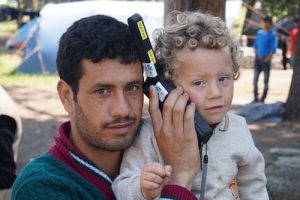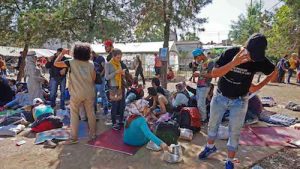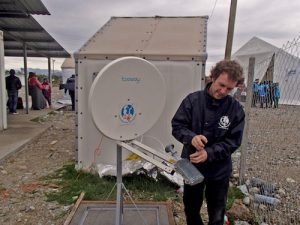
With the tragedy of refugees fleeing Syria and Iraq and beyond continuing unabated, SpaceWatch Middle East contributing editor Helen Jameson writes about how satellites can, in a small way, ease the plight of those fleeing the most awful violence and desperate conditions.
When did you last use your phone? Five minutes ago? An hour ago? Or perhaps you are using it whilst you’re reading this. Our communication links are incredibly important to us. We are constantly glued to social media, texting…keeping in touch with the minutiae of each other’s daily lives. But let’s imagine your phone is not working. Let’s imagine you have intermittent or no access to a phone network. Let’s imagine you have no means of communicating with the people you love when you are making the biggest and most dangerous journey of your life.
This is reality for every refugee fleeing war torn countries in the hope of finding a better life in Europe. These people are leaving their homelands with nothing but the very basics. But they will hold onto their precious mobile phones as though their life depended on it – because communication is a basic human need.
Let’s look at the situation today. Since 2015, the migrant crisis has dominated world headlines, and for very good reason. Millions of refugees have made the perilous journey from their stricken homelands with the hope of seeking asylum and better living conditions. Thousands have lost their lives along the way during hazardous land and sea crossings. According to UNHCR, 3,521 people have been reported dead or missing this year alone. The desperation to make it to Europe is overwhelming for these people and has forced them to take enormous risks to make it to Greek or Italian shores.
UNHCR states that the top three nationalities of refugee are Syrian, Afghan and Iraqi, but there are also huge numbers fleeing other countries in the Middle East and Africa such as Eritrea, Nigeria, Gambia and Sudan. Most arrive in Greece or Italy, after risking their lives on Mediterranean sea crossings where they are packed like sardines into flimsy boats with little or no safety measures.
If they complete this journey, on arrival in Europe, they are then processed and usually end up living in temporary refugee camps. The footage that we see on rolling news reports and the images that are splashed across the newspapers day after day only serve to remind us of the hardship that is being endured by these men, women and children. For the most part, these people are simply trying to seek a better life for their families. Life in their native countries has gradually become unsustainable. They are left with no choice but to look for something better.
The difference satellite can make

We know about the massive difference communications make in our daily lives, but for the refugee community, they are playing a critical role in the quest to help refugees find assistance, shelter and ultimately, a better life. It is very important to understand the huge difference that connectivity has in situations where there is chaos and panic. Satellite technology is playing its own, very critical role in the response to the migrant crisis.
Satellite has its own, unique and highly flexible features which mean that it is often the go-to solution in times of crisis. Satellite solutions are easily and rapidly deployable in areas where there is no terrestrial infrastructure. As long as you have line-of-sight with the satellite, you have a connection. A satellite link may therefore be established anywhere, yet can provide global coverage and a high quality of service for users.
Non-Governmental Organisation (NGO) Telecoms Sans Frontiere (TSF), has been involved in the relief effort since September 2015, and was present on the ground up until June 2016. TSF was the first NGO to specialise in telecommunications, and the group is dedicated to the provision of reliable connectivity in times of crisis and emergency for both first responders and victims.
Satellite is used extensively as part of TSF’s suite of communications, and was key to establishing connectivity at reception centres that quickly became the points of focus for arriving refugees. TSF initially established connectivity via satellite in Presevo, Serbia.
“TSF installed a satellite Internet connection and several access points in the Presevo One Stop Centre for the overseeing government body, the Humanitarian Community, United Nations agencies and migrants bottlenecked at the centre” explains Alexander James Thomas, Head of International Relations and Communication for TSF. “This operation was later reproduced in October of the same year in the Gevgelija Reception Centre, Macedonia. In October 2015, TSF installed 5 further satellite connections in Greece: 2 on the island of Lesbos (Skala & Moria), 1 on the island of Samos and 2 on mainland Greece in Idomeni at the crossing point between Greece and Macedonia.”
Reconnecting migrants with loved ones

The satellite connectivity that was installed at the reception centres served a dual purpose. The first was reconnecting the migrants themselves. For the majority of migrants, their mobile phone became their most treasured possession as they made their journeys to Europe. As their only link to the homes that they were fleeing and those they had left behind, they were extremely precious, with applications such as Facebook critical in enabling them to keep in touch with the families and friends. Not only this, the TSF team found that the phone represented empowerment for migrants as they could use their devices to respond to their own individual needs.
“Traditionally, populations affected by any crisis rely upon NGOs equipment or goods to benefit from aid – this can be anything from tents, to food to medicine – and in the past, TSF has indeed provided telephones to help migrants contact their loved ones” explains Thomas. “In this particular context, it was important for us to adapt to the situation in-hand. We noticed from talking with migrants that social networks and cross-platform communications applications were particularly important. Both serve as platforms to communicate widely with friends and family, whilst social media has also become a source of information for many”.
However, high roaming costs and a lack of Internet prevented many from using their mobile phones. Using satellite connectivity, TSF was able to provide Internet for up to 350 individuals simultaneously, giving them access to cross-platform communications apps (WhatsApp, Messenger), social networks (Facebook, Twitter) and importantly news sites where they could get the latest updates on the situation at home and in Europe. For many people who had left their home several weeks prior to arriving in the TSF-connected centres, these WhatsApp/Messenger (VoIP) calls were the first contact they had had with their loved ones in a long time. It is important to note that TSF’s connections are filtered to ensure that no undesirable content can be accessed and that the focus remains entirely on communication.
Connectivity for coordination
As we’ve seen, connectivity is vital for migrants to re-establish contact with their loved ones back home, but it was absolutely mission-critical for the humanitarian community working in the various centres. The reception centres could be quite chaotic places. Some days could see the arrival of up to 4,000 people and therefore coordination was key. The connectivity provided by TSF enabled each centre to communicate reliably with others, helping each location to better prepare for the arrival of migrants from one country to another.
“In total, TSF connected over 325,302 unique mobile devices between the period of September 2015 and June 2016, representing a total data transfer of 32,676 GB (31.91 TB)” Thomas says.
Restoring family links in Idomeni
In March 2016, European borders were blocked, leaving over 12,000 migrants stranded in Idomeni, Greece – the crossing point between Greece and Macedonia. As the situation became ever the more desperate in Idomeni, migrants were finding themselves victim of theft, in particular of telephones. Many people were gratuitously stripped of their mobile phones, or had lost them along their route.
“Whilst we had already installed 2 connections in 2015, Télécoms Sans Frontières deployed a team to respond to the communication needs of these migrants who no longer had mobile phones and had no contact with the outside world” Thomas continues. “Free calls were provided via satellite phones in and around Idomeni to a total of 2,778 families (representing 16,062 individuals) with 12,650 minutes of lifeline calls made to Syria, Iraq and Afghanistan”.
GEO-Information to help child refugees
The most heart-breaking aspect of the migrant crisis is the sheer number of children that have been caught up in the surge to Europe. Over half the approximate 60 million refugees that have fled their homes, are children.
Whilst TSF was focused upon re-establishing contact via satellite, connectivity from space has also been vital in terms of monitoring the migrant situation and expediting help where it is required.
SOS Children’s Villages is an NGO dedicated to the safeguarding of children and their families. The organisation has been on the ground, helping migrant children since the crisis began in September 2015 and has provided on-the-ground aid to displaced families and unaccompanied children in at least 14 countries. As of 2015, there were 573 SOS Children’s Villages around the world. Many of these villages are positioned to provide support for affected communities following a disaster. With established local networks in the communities, and high quality facilities, the organisation is often asked to act as a hub for partner organisations during emergency situations.
SOS Children’s Villages has teamed up with the University of Salzburg on a project that uses satellite imagery and geo-technology to enhance the organisation’s ability to respond to emergencies such as the migrant crisis. For humanitarian organisations, geo-information can be hugely beneficial and can provide essential information such as the location of roads and water sources. The partnership involves the Z_GIS department at the University of Salzburg, Austria, as part of its EO4HumEn+ project, which provides tailored information products based on Earth observation satellite images and geographic information to support humanitarian organisations.
Z_GIS is able to identify certain characteristics of refugee camps, such as whether the camp has a high population density, or the direction in which the camp is growing. Z_GIS is already partnered with Médecins Sans Frontières to assess the needs of camps for refugees and internally displaced persons. The more detailed information that is available to humanitarian actors, the better they are equipped to respond. They can assess risk much more effectively, for example, and can therefore support more children and families.
“This partnership will allow us to assess the vulnerability of a region and prepare for a crisis” says Andreas Papp, International Director of Emergency Response. “If the SOS Children’s Village is secure and has enough resources, we have a responsibility to help children and families in the local area. Through our work with Z_GIS, we can anticipate what we need and better support the local community in our emergency response work”.
Satellite for the greater good
It can be easy to dismiss satellite technology as just another way to communicate, but it is so much more than that. There is no other means of connectivity that is so independent and flexible, deployable with no other terrestrial requirements. For the migrants making their hellish journey across Europe, a communications hub equates to a lifeline. It provides help, information, aid – but most importantly, it provides that call to loved ones and the chance to say “Hello. Don’t worry. I am ok”.
Communications are vital for the entire relief effort that continues across Europe. Satellite, in tandem with other communications technologies such as radio, cellular and Wi-Fi, is helping to bring vital connectivity to refugees and the relief agencies providing invaluable support. Communications enable better co-ordination for those who need help. Simple access to the Internet, for example, can help the refugees to help themselves and to seek their own way through sourcing information on the Web, empowering them and enabling them to see past their current situation.
Along with food, warmth and shelter, the ability to communicate is essential.
The next time you pick up your mobile device to send a message or make a call, spare a thought for those who don’t have access to something that most of us take for granted.
Original published at: http://spacewatchme.com/2016/10/hello-im-ok/
 SpaceWatch.Global An independent perspective on space
SpaceWatch.Global An independent perspective on space

